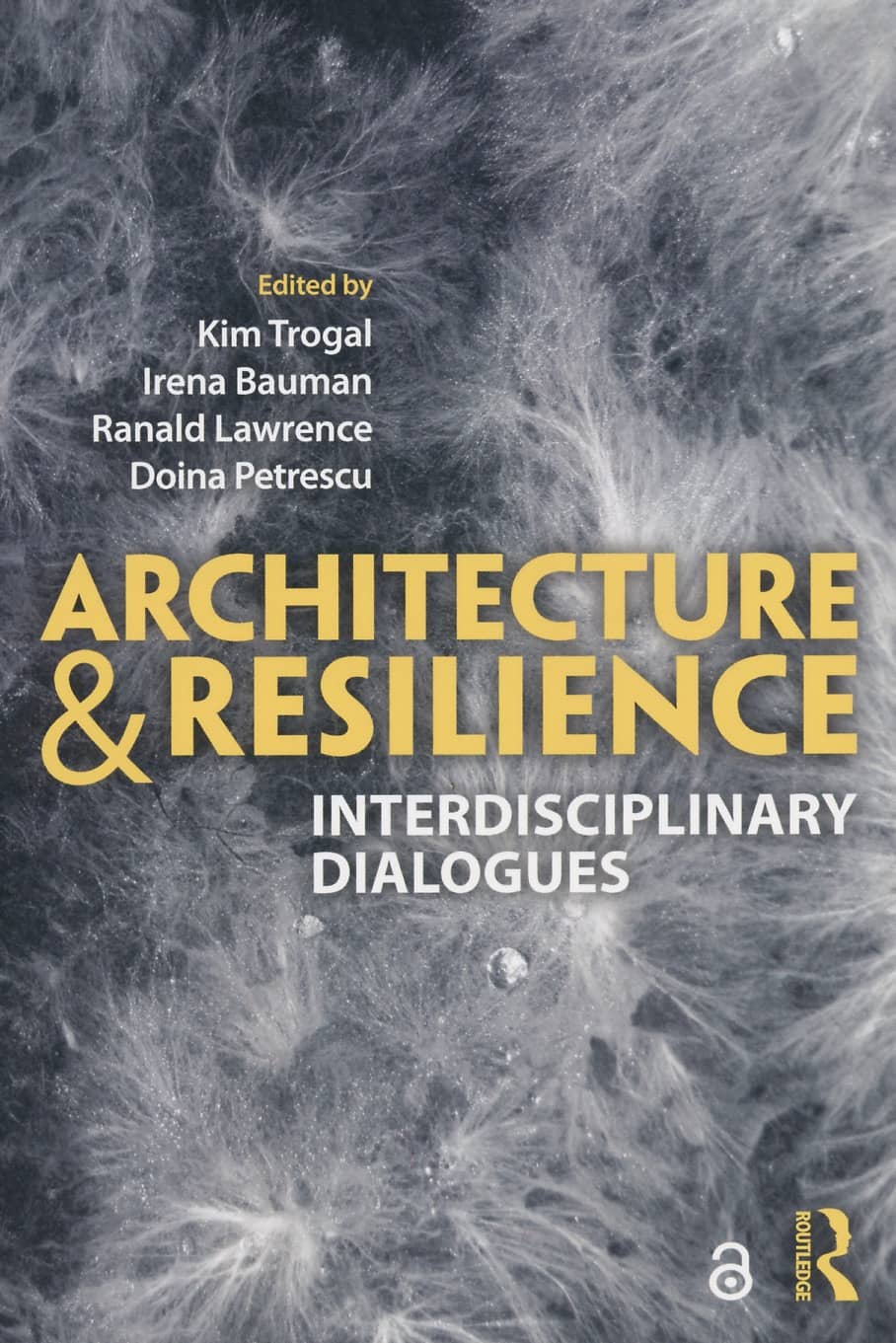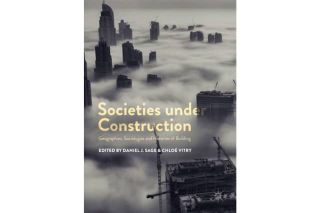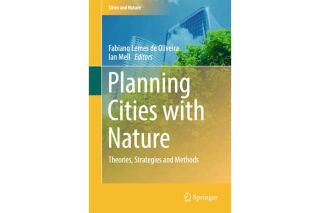
www.buildingsandcities.org/insights/reviews/architecture-and-resilience-review.html
Architecture and Resilience: Interdisciplinary Dialogues
Edited by Kim Trogal, Irena Bauman, Ranald Lawrence and Doina Petrescu. 2019, Routledge, ISBN: 9781138065819
Vanesa Castán Broto (Sheffield Urban Institute) reviews this book which explores resilience in architecture across community and urban scales. Factors considered range from the 'right to housing' to the role of the architectural profession.
 The growing interest in resilience has
motivated a renewed engagement with socio-ecological questions. One of its
manifestations has been the rich interdisciplinary dialogue on display in this
book. Resilience, the editors explain, has moved from being a radical term to
reimagine reciprocal relations to ecosystem, to being a catch-all term that
simply describes a certain capacity to deal with uncertainties and catastrophes
(Chapter 1). To counteract this, the book proposes to rethink resilience 'at a
human scale'. In doing so, the authors embrace resilience not as a new term of
managerial speak to reproduce well churned architectural ideas, but as a means
to generate engagements with people within their built environment through
creative and participatory methodologies.
The growing interest in resilience has
motivated a renewed engagement with socio-ecological questions. One of its
manifestations has been the rich interdisciplinary dialogue on display in this
book. Resilience, the editors explain, has moved from being a radical term to
reimagine reciprocal relations to ecosystem, to being a catch-all term that
simply describes a certain capacity to deal with uncertainties and catastrophes
(Chapter 1). To counteract this, the book proposes to rethink resilience 'at a
human scale'. In doing so, the authors embrace resilience not as a new term of
managerial speak to reproduce well churned architectural ideas, but as a means
to generate engagements with people within their built environment through
creative and participatory methodologies.
The words 'tour de force' came immediately to mind as soon as I sat with the book of Trogal and colleagues in my hands. This book is a tour de force, no doubt. If a tour de force is a display of strength, this book displays strength in three different ways. First, the book demonstrates the power of a diverse, interdisciplinary community of scholars exploring possible responses within the built environment to the current age of climate turbulence. Second, the book showcases the strength of the debate on resilience within architecture. Third, the book also showcases the strength of edited collections to foster constructive debates within a given field.
This final point is one of contention in contemporary academia, so let me dwell a bit on it. Edited collections seem to lose value among academics. There is a perception that they are poorly cited and that they hold less weight in the performance evaluations that shape academics' careers. However, edited collections also have many advantages: they make writing accessible to early career researchers roaming in libraries (at least before COVID-19!), they create alternative spaces for creativity, enabling networking and connection across a given field or topic, and they provide the opportunity for receiving feedback from editors in a different tone than the relatively cold reviews that one gets from journals. Webster (2020) argues that rather than being incoherent collections of work, edited collections advance the discipline. Through editor-driven intellectual exchanges that involve trust and mutual obligations, edited collections showcase the limits of the debate and point towards new, unexplored directions. Not all edited collections succeed in this endeavor, but Architecture and Resilience surely does.
The book is complex but very easy to navigate. The Introduction frames the intellectual project, which is then further developed in six 'dialogues.' Each 'dialogue' offers three to four diverse contributions that approach the overall theme from a different angle. Formats include essays, project reports, interviews, and visual analysis of photos, maps and diagrams. Dialogue I proposes looking into narratives of resilience emerging from responses to the devastation of the war in Sarajevo, from the delivery of practical projects or from the experience of working with refugees in Calais (as reported in an interview with Grainne Hasset). Dialogue II turns to the idea of the 'right to housing' as a means to discuss community resilience. It explores how strategies such as community housing, affordable eco-housing, and auto-organisation facilitate claiming the right to the city, or right to settlement, through housing. Dialogue III puts pedagogy at the center of the debate. From comparing studio approaches to thinking about the pedagogical role of the university, the section emphasizes that resilience thinking can transform current practices of teaching and thus, it challenges architecture as a profession (see Chapter 10). Dialogue IV situates architectural practice within a broader social context through the examination of climate denial. Climate denial is a scourge of our times. The 'culture of uncare' that exacerbates denialism can be best challenged by practical ideas to develop adaptive capacity. Dialogue V explores resilience as a relational practice that depends on interactions, networks, and a recognition of interdependence. Resilience, in this section, depends on the relations that maintain us within and beyond the world, whether this is in imaginary communities, the development of car practices or the reflection of the significance of an organic internet. Finally, Dialogue VI reviews the scales of resilience and the insertion of the city in global processes. Resilience can only be understood in relation to multi-level, nested responses from the global sphere to the neighbourhood.
This short summary cannot do justice to the variety of contributions. One of the features of this volume is the inclusion of several interviews. The interviews offer a window into the messiness of architectural practice, away from the argument-driven narrative of the academic essay. Daniel D'Oca, Principal and co-founder of Interboro Partners, for example, voices concern about the very term 'resilience' but remarks that it is a word that foregrounds agency. His preoccupation is to engage grassroots organizations in the design of regional-oriented ideas. The interview with Tina Saaby, Chief City Architect of Copenhagen, reveals the contradictions of neighborhood-based planning in the city. The interviews punctuate the collective narrative with distinctly spoken sentences that bring the theme of architecture and resilience to life.
This book can be used in multiple ways, and, hence, it speaks to different audiences. The book is both a repository of approaches and orientations to resilience in the built environment and a forceful argument to rethink resilience at a human scale. The book is also a source of ideas, both in terms of consolidated views and widely imaginative propositions. It finds inspiration in climate change debates as much as in post-war or migrant contexts. The book is mostly written in plain language. Academics already working in the field of resilience will benefit from reading this book as much as those with only a marginal interest. Practitioners will find the book useful, and several chapters are written in a style that bridges academic insight and practical wisdom. I hope Architecture and Resilience will promote resilience actions based on life practices and implicated on just urban politics.
Reference
Webster, P. 2020. The Edited Collection: Pasts, Present and Futures. Cambridge University Press.
Latest Peer-Reviewed Journal Content
A framework for 1.5°C-aligned GHG budgets in architecture
G Betti, I Spaar, D Bachmann, A Jerosch-Herold, E Kühner, R Yang, K Avhad & S Sinning
Net zero retrofit of the building stock [editorial]
D Godoy-Shimizu & P Steadman
Co-learning in living labs: nurturing civic agency and resilience
A Belfield
The importance of multi-roles and code-switching in living labs
H Noller & A Tarik
Researchers’ shifting roles in living labs for knowledge co-production
C-C Dobre & G Faldi
Increasing civic resilience in urban living labs: city authorities’ roles
E Alatalo, M Laine & M Kyrönviita
Co-curation as civic practice in community engagement
Z Li, M Sunikka-Blank, R Purohit & F Samuel
Preserving buildings: emission reductions from circular economy strategies in Austria
N Alaux, V Kulmer, J Vogel & A Passer
Urban living labs: relationality between institutions and local circularity
P Palo, M Adelfio, J Lundin & E Brandão
Living labs: epistemic modelling, temporariness and land value
J Clossick, T Khonsari & U Steven
Co-creating interventions to prevent mosquito-borne disease transmission in hospitals
O Sloan Wood, E Lupenza, D M Agnello, J B Knudsen, M Msellem, K L Schiøler & F Saleh
Circularity at the neighbourhood scale: co-creative living lab lessons
J Honsa, A Versele, T Van de Kerckhove & C Piccardo
Positive energy districts and energy communities: how living labs create value
E Malakhatka, O Shafqat, A Sandoff & L Thuvander
Built environment governance and professionalism: the end of laissez-faire (again)
S Foxell
Co-creating justice in housing energy transitions through energy living labs
D Ricci, C Leiwakabessy, S van Wieringen, P de Koning & T Konstantinou
HVAC characterisation of existing Canadian buildings for decarbonisation retrofit identification
J Adebisi & J J McArthur
Simulation and the building performance gap [editorial]
M Donn
Developing criteria for effective building-sector commitments in nationally determined contributions
P Graham, K McFarlane & M Taheri
Reimagining circularity: actions for optimising the use of existing buildings
R Lundgren, R Kyrö, S Toivonen & L Tähtinen
Effective interdisciplinary stakeholder engagement in net zero building design
S Vakeva-Baird, F Tahmasebi, JJ Williams & D Mumovic
Metrics for building component disassembly potential: a practical framework
H Järvelä, A Lehto, T Pirilä & M Kuittinen
The unfitness of dwellings: why spatial and conceptual boundaries matter
E Nisonen, D Milián Bernal & S Pelsmakers
Environmental variables and air quality: implications for planning and public health
H Itzhak-Ben-Shalom, T Saroglou, V Multanen, A Vanunu, A Karnieli, D Katoshevski, N Davidovitch & I A Meir
Exploring diverse drivers behind hybrid heating solutions
S Kilpeläinen, S Pelsmakers, R Castaño-Rosa & M-S Miettinen
Urban rooms and the expanded ecology of urban living labs
E Akbil & C Butterworth
Living with extreme heat: perceptions and experiences
L King & C Demski
A systemic decision-making model for energy retrofits
C Schünemann, M Dshemuchadse & S Scherbaum
Modelling site-specific outdoor temperature for buildings in urban environments
K Cebrat, J Narożny, M Baborska-Narożny & M Smektała
Understanding shading through home-use experience, measurement and modelling
M Baborska-Narożny, K Bandurski, & M Grudzińska
Building performance simulation for sensemaking in architectural pedagogy
M Bohm
Beyond the building: governance challenges in social housing retrofit
H Charles
Heat stress in social housing districts: tree cover–built form interaction
C Lopez-Ordoñez, E Garcia-Nevado, H Coch & M Morganti
An observational analysis of shade-related pedestrian activity
M Levenson, D Pearlmutter & O Aleksandrowicz
Learning to sail a building: a people-first approach to retrofit
B Bordass, R Pender, K Steele & A Graham
Market transformations: gas conversion as a blueprint for net zero retrofit
A Gillich
Resistance against zero-emission neighbourhood infrastructuring: key lessons from Norway
T Berker & R Woods
Megatrends and weak signals shaping future real estate
S Toivonen
A strategic niche management framework to scale deep energy retrofits
T H King & M Jemtrud
Generative AI: reconfiguring supervision and doctoral research
P Boyd & D Harding
Exploring interactions between shading and view using visual difference prediction
S Wasilewski & M Andersen
How urban green infrastructure contributes to carbon neutrality [briefing note]
R Hautamäki, L Kulmala, M Ariluoma & L Järvi
Implementing and operating net zero buildings in South Africa
R Terblanche, C May & J Steward
Quantifying inter-dwelling air exchanges during fan pressurisation tests
D Glew, F Thomas, D Miles-Shenton & J Parker
Western Asian and Northern African residential building stocks: archetype analysis
S Akin, A Eghbali, C Nwagwu & E Hertwich
Join Our Community

The most important part of any journal is our people – readers, authors, reviewers, editorial board members and editors. You are cordially invited to join our community by joining our mailing list. We send out occasional emails about the journal – calls for papers, special issues, events and more.
We will not share your email with third parties. Read more



Latest Commentaries
COP30 Report
Matti Kuittinen (Aalto University) reflects on his experience of attending the 2025 UN Conference of the Parties in Belém, Brazil. The roadmaps and commitments failed to deliver the objectives of the 2025 Paris Agreement. However, 2 countries - Japan and Senegal - announced they are creating roadmaps to decarbonise their buildings. An international group of government ministers put housing on the agenda - specifying the need for reduced carbon and energy use along with affordability, quality and climate resilience.
Building-Related Research: New Context, New Challenges
Raymond J. Cole (University of British Columbia) reflects on the key challenges raised in the 34 commissioned essays for Buildings & Cities 5th anniversary. Not only are key research issues identified, but the consequences of changing contexts for conducting research and tailoring its influence on society are highlighted as key areas of action.